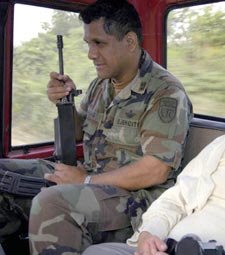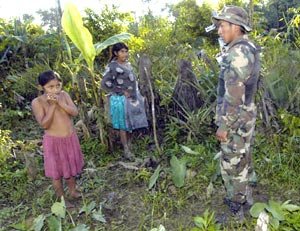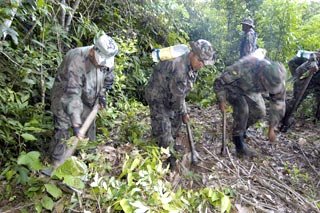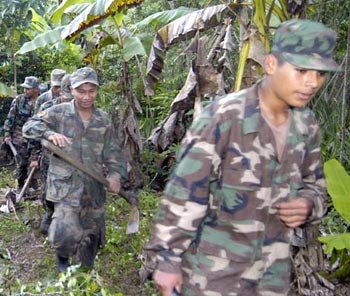


A Sunrise Raid on a Coca Field
With the “Anti-Drug” Soldiers in Bolivia’s Chapare
By Amber Howard
2004 Narco News Authentic Journalism Scholar
August 7, 2004
CHIMORÉ, BOLIVIA, AUGUST 4, 2004. ARRIVAL TIME 05:05 HOURS: We arrive in the still dark hours, stumbling from the taxi over the handmade rock road into the base of the military unit that calls itself the Special Forces in the Struggle Against Narco-Trafficking. We walk past soldiers shouting out responses to their commanders as they stand shivering in the still surprisingly chilly morning air in the Chapare, a tropical region in central Bolivia known for coca production. As we wait for our transport to the eradication site, we are ushered into a cafeteria-like barrack where we are graciously offered a breakfast of bread, butter, caramel, coffee and tea. The irony is great. The military base attempting to conquer narcotrafficking serves nothing less than tea made from the same plant we were going to destroy – coca. Nothing better to get you out of bed in the morning and ready for a full day of eradication.
I’m curious about the disconnect between the stigmatization of the coca leaf, necessary for those here who extinguish it in fields every day, and enjoying that same leaf it one’s morning tea. But I decide to just enjoy the delicious flavor mix of Windsor’s TRI-MATE: coca, chamomile and anise. As we leave the eating lounge and make our way outside into the still pitch black early morning, we start to wonder if we missed the trip altogether. Despite rushing out to capture any potential action, we are confronted with nothing more than the sound of grasshoppers, yellow-white fluorescent lights that will be used to illuminate a baseball field, and several young soldiers, dressed in camouflage provided by the United States of America. At a closer look, absolutely everything they wear from the black, green splotched colored jackets and pants, tucked into their black commando boots—including even the waist belt with space for water bottle, artillery and guns—comes from this imperial power.
Dawn approaches, the air starts to warm up, but the silence contains a certain amount of eeriness – as if it were holding something unknown on the horizon, waiting for us. We watch as various tanks and other large vehicles pass us by. Soon it will be our turn to jump aboard, to trust the security of the mission, and our own strength as authentic journalists. As the red sun rises along the underbelly of the earth, I take a deep breath and realize that this is what investigative journalism is all about. Intent on discovering and reporting the other side of the story – that of the enemy – concern about risk goes out the window for us.
Finally, just as the clouds are starting to turn yellow with the approaching light, a red Land Rover pulls up and stops right in front of us. “¿Van a la eradicación?” (“are you going to the eradication?”) asks our brave team leader Jeremy Bigwood of the driver. “¿Ustedes son las de la prensa norteamericana?” (“Are you the ones from the American press?” is the response. I bite my lip and let the other more experienced journalists field this question.
 Lieutenant Antonio Arias Photo: Jeremy Bigwood D.R. 2004 |
We drive for about an hour, farther and farther out into the countryside of what we are told is Puerto Andino. I start to doze off because of the early hour and lack of sleep the night before, and wake up to a halt in the rocky, jolting ride. The driver, apparently lost, has come to a dead end at the gates of a REPSOL gas plant. My curiosity abounds and I decide to look more into the connections between oil and eradication. I know that in programs like the Plan Colombia, the military is often present simply to protect oil interests in the area, rather than really trying to eradicate coca. Could it be the same in Bolivia? What about the other countries in the area with similar patterns of indigenous people, oil resources and militarization?
These are my thoughts as we peel out and head back to the road. Faces look up at us. We pass in a red flash. From the side of the road, people stare at us, it seems, with feelings of guarded mistrust, suspicion pelting against the window from families and groups of people standing together. It’s obvious they know who we were and what we have come to do.
 Photo: Jeremy Bigwood D.R. 2004 |
I can’t help but stop to give the señora a moment to express herself, to let me know what she is going through: “Les han sacando todos. Son chiquititos. ¿Porque están sacando?” (“They are taking it all. They are small plants. Why are they taking them?”) She tells me about her children and how they are trying to go to school, and how she needs the money from these coca plants to make this happen. I ask her how long she has been living there, and she tells me eight years.
As I watch her tears fall, my heart drops down into the mud. I want to tell her I understand her pain, that I see the injustice and want to help. But I have to walk away. My anger is not for the soldiers, because they are just doing as they are told. It is for something bigger. It’s the unfairness of it all. This woman had a small crop and they destroyed it. Why? I feel like a traitor for being seen with the enemy. Here we are trompsing down the same path that these people use every day to get to their field, to take care of their crops. The trail is wet, we slip and slide our way through mud up to our ankles. Soon we arrive at a clearing, a small area of about 30 square feet.
 Photo: Jeremy Bigwood D.R. 2004 |
All around us we hear the chop, crack, slice of the machetes cutting through the thin trunk of the plants. Everywhere the same sound of death. This is a war, a war against coca, and these soldiers, along with the growers themselves, are victims. They waste no time, some cutting down the plants with the machetes, others yanking them right up out of the ground, still more with hoes tearing the earth down to dirt. Next they march in lines, shoulder to shoulder, vigilant, to make sure they found everything. “One more revision, to leave nothing behind,” he tells me. I look for signs of compassion in their faces, anything, some sign of humanity, but they continue as though they were robots of a larger machine. But upon reflection, I realize they are just kids, so young, doing what they are told. They stampede through the the now vanquished field. I watch as one bends down to pluck out a tiny sprout. I grasp the severity of the mission.
Soldiers enlisted in the Air Force, Navy, and police departments all work together in these operations to perform the eradication. All of the soldiers have guns and water bottles on their backs, and each carries some sort of destruction tool. They tell me they work every day from 5 to 6 o’clock in the morning until 2 to 3 in the afternoon, because after that it is too hot out. Within 20 minutes of our arrival, they have already completed their mission, with approximately sixty soldiers all around, working hard. Wilbur Hellis is 17 years old and from Potosí. He, like most of the soldiers, is completing his obligatory one-year stint in the Bolivian military.
 Photo: Jeremy Bigwood D.R. 2004 |
Upon return to the road, the soldiers pile into the back of a huge truck. It’s open with no roof or walls, just metal bars holding them in. The image is frighteningly similar to one of farm animals, cows or pigs, innocently transported to slaughter to feed an unknown monster. All of them become one as they are jostled back to make room. Faces emerge among the forest of camouflage and hats, curiosity, distrust. Beneath this I feel a layer of submission emanating from the mass. My compañera Natalia at the last second decides to jump aboard. Her small stature, light skin and dark curls instantly vanish. She is swallowed up. The rest of us load into the Land Rover. It is hot now, sweat dripping off our brows, it is now around 8:30 in the morning. We are on our way to another coca field and soon to be place of eradication. My fellow journalists Jeremy Bigwood and Eartha Melzer and I sit down with Lieutenant Arias.
I want to understand where he is coming from, how he justifies this to himself. I ask what he thinks of the importance of his job. He tells me that he is maintaining the dignity of Bolivia, that when he eradicates a field of coca, he is making sure that coca isn’t used in drug production. I ask him what he thinks about the personal consumption of the leaf itself, and he tells me he is also avoiding the chance of more drug addicts in Bolivia and around the world.
I ask him if he believes that chewing coca leaf is a form of drug consumption. He answers by saying he knows that since the time of the Incas, coca has been used to take care of hunger and exhaustion and thirst, that it offers a sustenance to people as they work.
We are cut off as we pull up to the next site. We walk along the path with a chain link fence narrowly separating us from a REPSOL gas plant. I can see the flame of the burning of the excess gas. Even though we drove some 15 minutes between sites, both had a REPSOL plant right next to them. Could that be a coincidence? They tell us they are taking us to a larger coca field so we can film and take pictures.
Arias admits that the vast majority of fields these days are small, with small plants. He says that farmers now don’t plant large crops because they know soldiers will come to tear them down. Here there are no people in sight, only coca plants. It is a little larger than the first field, but not much, approximately half a hectare. We are told it takes about an hour to eradicate a field this size. There are other plants among the coca and I notice that the troops are careful not to damage these in the eradication. It also depends on how big or small the plants are, so of course it takes less time when the plants are smaller. Half of the group use a hoe and the other half use machetes.
As we talk a little more with the soldiers, they tell us that it is a lie when the people say this coca is going to to be chewed and not to the consumption of drugs. They have been told by their superiors that 80 to 90 percent of the coca goes to drug production. From my experience here in the Chapare and spending time with people, this is hard to believe. Are the high numbers a way for the police and others to justify their presence in the region? A pretext of saving people from the evil drug trade makes it easier to wipe out someone’s crop than if the coca was just for personal consumption.
The military officials try to tell us that no one chews the coca grown in the Chapare but after what we viewed at the Sacaba market, we know there is a lot of trade going on between people in small amounts, mostly for traditional use. Sergeant Espinoza admits that there are very few large plantations these days. Almost all are small crops, planted among other crops on the mountain side, so that they can’t be identified by passing aircraft. It is hard for me to see the point of spending so much money just to get rid of people’s small farms. We leave shortly after, since there isn’t anything else for us to see – just more cutting. And if we come back tomorrow, or next week, or next month, or next year, it will probably be more of the same.
- The Fund for Authentic Journalism
For more Narco News, click here.




